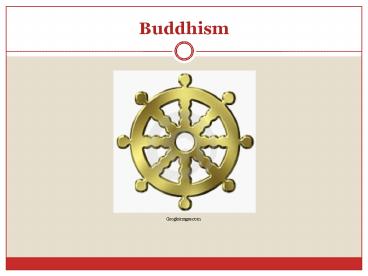Buddhism - PowerPoint PPT Presentation
1 / 21
Title:
Buddhism
Description:
Buddhism Googleimages.com A Way of Life To many, Buddhism goes beyond religion and is more of a philosophy or 'way of life' The major tenets are – PowerPoint PPT presentation
Number of Views:105
Avg rating:3.0/5.0
Title: Buddhism
1
Buddhism
Googleimages.com
2
A Way of Life
- To many, Buddhism goes beyond religion and is
more of a philosophy or 'way of life' - The major tenets are
- (1) to lead a moral life(2) to be mindful
and aware of thoughts and actions(3) to develop
wisdom and understanding - (Introduction to Buddhism)
3
Who was the Buddha?
- Born Siddhartha Gautama in 563 B.C.E.
- He was of the noble caste in India
- At the age of 29 he rejected the life of luxury
- He sought enlightenment and the solution to
suffering (Introduction to Buddha)
Googleimages.com
4
The Wandering Ascetic
- He followed a strict ascetic lifestyle for six
years - Then he realized even this was too extreme
- He became Buddha, the Awakened Oneat the age of
35 - He spent the remaining 45 years of his life
teaching others how to achieve the peace of mind
he had achieved - (Introduction to Buddha)
5
The Four Noble Truths
- 1- To live is to suffer
- 2- The cause of suffering is self-centered desire
attachments - 3- The solution is to eliminate desire and
attachment, thus achieving Nirvana (extinction) - 4- The way to Nirvana is through the Eight-Fold
Path -
(Introduction to Buddhism)
6
What is the Eight-Fold Path?
- Wisdom
- Right understanding
- Right motivation
- Moral discipline
- Right speech
- Right action
- Right livelihood
- Mental discipline
- Right effort
- Right mindfulness
- Right meditation
7
Three Marks of Existence
- Anicca (Sanskrit anitya) impermanence
- Dukkha (Sanskrit duhkha) unsatisfactoriness
- Anatta (Sanskrit anatman) non-self
- (Three Marks of Existence)
8
Buddhist Metaphysics
- Dukkha life in this world is filled with
suffering - Anicca everything in this world is impermanent
- Anatta the self/soul is also impermanent there
is no eternal, unchanging self (no soul no
atman) - (Metaphysics)
9
What do Buddhists believe?
- Rebirth (reincarnation) results from attachments
(karma) - Nirvana is a peaceful, detached state of mind
- Once Gautama Buddha died, after 80 years of life
in this world, having achieved Nirvana and
teaching multitudes his way of life, he ceased to
exist as a distinct being - Buddhism is non-theistic Buddha is not the
Buddhist God he is just a revered teacher
10
How are Buddhism and Hinduism Similar?
- Buddhists and Hindus believe
- Karma is a cycle of cause and effect
- Similar actions will lead to similar results
(Santina) - Dharma is duty
- Samsara is the cycle of rebirth
- (Major Differences)
11
How are Buddhism and Hinduism Different?
- Buddhism rejects
- Authority of the ancient Vedic texts
- The Vedic caste system
- The Vedic and Hindu deities
- The efficacy of Vedic worship and ritual
- The concept of Brahman
- (Major Differences)
12
For Example
- There are no supreme dieties in Buddhism
- Buddha is not an Avatar, he is a holy man
- Buddha is omniscient, not omnipotent
- Moksha is happiness on earth while Nirvana is an
escape from it entirely - (Major Differences)
13
Schools of Buddhism - Theravada
- Oldest school of Buddhism
- Found in southern Asia (Sri Lanka, Burma,
Thailand, etc.) - Monasticism is the ideal life for achieving
Nirvana - A do-it-yourself approach to enlightenment
- Focus on wisdom and meditation
- Goal is to become a Buddha
- Pali Canon word of Buddha
- (Theravada Ideal)
Buddhanet.net
14
Schools of Buddhism - Mahayana
- Developed first century C.E.
- Found in Northern Asia (China, Japan, etc.)
- Buddhism for the masses
- Group, not individual end to suffering
- Believe Buddhas can help lead to enlightenment
- "Agamas" as well as Pali Canon
- Diverse schools and sects
- (Bodhisattva Ideal)
Buddhanet.net
15
Schools of Buddhism - Tibetan
- Developed 7th century C.E.
- A mix of Theravada Mahayana
- Rituals (Tantra)
- Mantras (chanting)
- Mandalas Thankas (symbolic images)
- Mudras (hand gestures)
- Bodhisattvas, including living Lamas (Dalai Lama)
- Scriptures
- Between the 11th and 14th centuries, the Tibetans
translated every available Buddhist text into
Tibetan.. - Tibetan Book of the Dead
Buddhanet.net
16
Schools of Buddhism Zen
- The meditation school
- Seeks sudden enlightenment (satori) through
meditation, arriving at emptiness (sunyata) and
the Buddha Nature - Use of meditation masters (Roshi)
- Beauty, arts aesthetics gardens, archery, the
tea ceremony, calligraphy, etc.
17
What are some Buddhist texts?
- Tripitaka aka the Three Baskets
- Vinaya (discipline) rules for monastic life
- Sutta (discourse) sermons of the Buddha
- Abhidhamma (metaphysical teachings)
- Dhammapada collected sayings of the Buddha
18
The Spread of Buddhism
- Within two centuries after the Buddha died,
Buddhism began to spread north and east into Asia - By 13th century Buddhism had disappeared from
India
Buddhanet.net
19
Buddhist Populations
Buddhanet.net
20
A quick note about the Citations
- All of the information in this presentation comes
from Buddhanet.net - The citations reference the articles on the cite
21
(No Transcript)































